A Snapshot of Sites Along the Byway
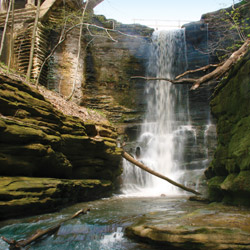
The Illinois River Road National Scenic Byway follows routes along both sides of the river, uniting more than 100 nature-based destinations throughout this beautiful valley in a 291-mile circular path stretching from Ottawa in the north to Havana in the south. With a wealth of opportunities for historic exploration, scenic views and outdoor activities, the Illinois River Road is an ideal way to enjoy much of what the state has to offer.
What follows is merely a snapshot of the some of the many sights to see along the Illinois River Road.
Plan Your Itinerary!
The Illinois River Road National Scenic Byway was honored by the Illinois Bureau of Tourism with the Best Tourism Website award in 2008. The interactive site includes detailed information on each of the gateway communities and more than 100 nature-based destinations along the Byway. Visitors can plan itineraries and share memories by posting pictures and stories from their trips in the “Tales from the Illinois River Road” section.
The site offers five predefined itineraries available for download. You can also develop your own itinerary by visiting illinoisriverroad.org and clicking on “Plan Your Itinerary.” As you view different destinations on the site, click the "Add to My Itinerary" icon to store your favorite attractions in your own custom itinerary. You can even search by interest, such as “birding” or “biking.”
Central/Northern Byway Itinerary
This three-day itinerary begins at the northern end of the Byway with a full day in the Ottawa area, including stops at the Illinois Waterway Visitors Center, a visit to Matthiessen State Park, shopping in Utica and dinner and overnight accommodations in Ottawa. Day Two starts at Hennepin Canal Parkway State Park near Sheffield and continues with shopping in Princeton, visits to Hornbaker Gardens, Condit’s Ranch and Stables, and Marshall State Fish & Wildlife Area. The day wraps up by traveling south to Peoria for dinner and a tour of the Kickapoo Creek Winery. Day Three showcases some of the Peoria area’s most popular attractions, from Forest Park Nature Center and Wildlife Prairie State Park to Luthy Botanical Garden and the Peoria Zoo—home to more than 100 species of animals.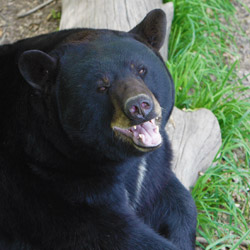
Central/Southern Byway Itinerary
Day One of this two-day itinerary starts at the wetland areas of the East Peoria Riverfront Greenway and continues along the River Trail of Illinois connecting East Peoria to Morton. After lunch and a stop at Lakeview Museum, visit Lavender Creek Farm and Mackinaw Valley Vineyard before dining and staying in Peoria or East Peoria. Day Two features visits to Fort Crevecoeur Park, McNaughton Park, the Rockin’ P Public Riding Ranch and lunch along Pekin’s Main Street. In the afternoon, stop by Willett’s Winery and Cellar, Jake Wolf Memorial Fish Hatchery and Chautauqua National Wildlife Refuge, before strolling the tree-lined streets of historic Havana and choosing a dinner destination.
Southern Byway Itinerary
Day One begins at Lakeland Park north of Canton, with its five lakes, walking/biking trails, boat launching facilities and fishing piers. Stops at Banner Marsh State Fish and Wildlife Area and The Nature Conservancy’s Emiquon Preserve will be paradise for nature lovers; and then a final stop at Dickson Mounds Museum. On Day Two, relax and watch wildlife at Havana’s Riverfront Park, go birding at Chautauqua National Wildlife Refuge, visit the Jake Wolf Memorial Fish Hatchery and finish your day at Sand Ridge State Forest, with its vast amount of sand deposited from glacial melt-waters and sculpted into massive dunes.
Family Fun Byway Itinerary
Three days of fun for the whole family await you on this itinerary! On the first day, marvel at the sandstone canyons of Starved Rock State Park, board the LaSalle Canal Boat for a relaxing ride along the historic Illinois & Michigan Canal, and visit the petting zoo and corn maze at Boggio’s Little Mountain Orchard. Stop by Apple Blossom Farm and the Wheels O’ Time Museum before taking in the action at a Peoria Chiefs game. Day Two showcases some of Peoria’s finest attractions: the 2,000-acre Wildlife Prairie State Park, Lakeview Museum, the Spirit of Peoria, Peoria Zoo, Detweiller Golf Course and Forest Park Nature Center. Finish your evening with a local theater production at Eastlight Theatre, Corn Stock Theatre, Conklin’s Barn II Dinner Theatre or Peoria Players Theatre. Take a trip back in time on Day Three with a trolley tour of Peoria’s illustrious past, featuring guides from the Peoria Historical Society, and finish the day at Dickson Mounds Museum.
Visit illinoisriverroad.org to download these itineraries—or create your own!
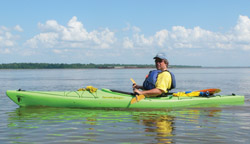 Fox Tales on the River Road
Fox Tales on the River Road
iBi asked storyteller Brian “Fox” Ellis to highlight some of the hidden gems along the Byway. Fox noted that there are dozens of places he would recommend, but here are several that he shared with us:
- For canoeing or kayaking on a hot summer day when the creeks and tributaries are too low, I love to paddle the Illinois River from Shore Acres in Chillicothe. You can park right next to the river, put your boat in the water and paddle out around the man-made islands on the other side. With a simple figure-eight around a few islands, you can cover several miles and easily get right back into your car and go. The park also has picnic benches and grills if you want to grill some burgers or dogs, as my family did on my birthday last year.
- For bird watching, a loop that includes both Emiquon, near Dickson Mounds, and Chautauqua National Wildlife Refuge, near Havana, will provide even an amateur birder with many memorable sights. Since they have re-flooded Thompson Lake, there have been Black-necked Stilts nesting there for the first time in modern memory. These are amazing little shore birds that look like they are wearing tuxedos with hot pink leggings!
- Of course, Dickson Mounds is a great place to visit and a great place to come back to if you have not been in a while. They are working closely with The Nature Conservancy, who owns Emiquon, to interpret the relationships between Native Americans and the natural world.
- On the north end of the Illinois River Road, Ottawa has so much history you could spend several days and barely skim the surface—from the Lincoln-Douglas debates to the Boy Scout Museum, Starved Rock to the I & M Canal. Ottawa also has costumed historical re-enactors who roam the streets during the summer and help folks connect with the layers of history. And for the size of the town, I was most impressed with the variety of eats and drinks, with the usual host of fast food and chains, but also quite a number of unique local establishments for both fine dining and a quick burger with local flavor.
- LaSalle now boasts a working canal boat pulled by mules for those who truly wish to time travel.
- Spring Valley hosts an annual fishing tournament, which also implies that the fishing is good year ‘round, and there are boat ramps on both sides of the river. There is a marina on the south side of the river that has great food and drinks after a long day of fishing or boating.
- Check ahead for times, but if you are a fan of carved duck decoys, it is worth the pilgrimage to Henry to visit the Perdew Workshop and Museum.
Canyons and Waterfalls
Starved Rock State Park is one of the most beautiful places in the Midwest, with 2,816 acres that offer 18 distinct sandstone canyons and 15 miles of trails, featuring various kinds of plants and wildlife. White-tailed deer are particularly popular for wildlife watchers, as are red-tailed hawks. The park is also known for beautiful wildflowers and its state-of-the-art visitor center with interactive displays, guided hiking tours and nature programs.
Just down the road is Matthiessen State Park, which boasts 2,000 acres of prairies, bluffs, waterfalls, deep ravine forests and sandstone canyons cut by the Vermilion River. Matthiessen is a treasure for birders and nature photographers, and offers numerous hiking and equestrian trails, an archery range and campgrounds.
The Spirit of Peoria paddle wheeler travels the Illinois River between Peoria and Starved Rock State Park every week from June through October. The two-day cruise sets out from the Peoria Riverfront and features an overnight stay at the historic Starved Rock Lodge. Riverlorian Brian “Fox” Ellis shares the history of the river through stories and songs, while world-class ragtime piano player Bev Wolf, and musician Barry Cloyd entertain guests along the way. Visit spiritofpeoria.com for dates and times.
Happy Trails To You
Last August, National Geographic Adventure magazine selected Peoria as one of its “50 Next Great Adventure Towns” in which to live and play. The only Illinois city on the list, Peoria was credited for its growing miles of bike trails that surround the city. The Peoria Area Mountain Bike Association (PAMBA) promotes off-road bicycling through education, trail creation and maintenance, and social events. Their members can be found on five major trails:
- Jubilee College State Park is home to the largest single-trail system in the area. Mountain bikers and equestrians enjoy the park, with its fast downhills, large climbs and singletrack area (trails only as wide as a bike) for hikers and bikers.
- Black Partridge Park in Metamora is the area’s newest trail system, with trails still being created today. When complete, the park will host over 15 miles of singletrack.
- The trails at Dirksen Park in Pekin offers grinding climbs, tight singletrack and sharp descents.
- Farmdale Reservoir east of Peoria offers about 20 miles of trails, including a mix of fast open stretches and twisty turns. The reservoir also has a downhill run, MTX/dirt jump course and a stunt loop.
- Independence Park, also known as Marquette Heights Trail, consists of 12 miles of singletrack, with challenging hills and descents and natural obstacles.
Other popular trails include:
- Rock Island Trail, 29 miles of crushed limestone that winds through farmland and prairie grass from Alta to rural Toulon
- River Trail of Illinois, a 10-foot wide, hard-surfaced hiking/biking trail running from East Peoria to Morton
- Hennepin Canal Trail, 91 miles of trail near Sheffield for hiking, biking and snowmobiling
- Washington Recreation Trail in nearby Washington has doubled its length to six miles, with additional expansion plans.
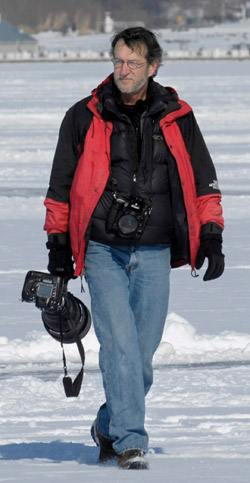 The River as Muse
The River as MuseThe artist David Alan Badger and photographer David Zalaznik have both been hard at work on projects featuring the Illinois River as the centerpiece. Badger is a self-taught artist from Havana, who has penned 8,000 drawings of Illinois architecture over the last 27 years. On April 7th of this year, he began traveling the Illinois River Road National Scenic Byway to capture its beauty in pen-and-ink drawings for a series of keepsake books. Working with businesses and sites along the Byway, he is pairing these drawings with recipes and other information to create a “Taste of the Region.”
When the series is complete, there will be seven books in all—one for each of Illinois’ scenic byways—which will be sold to travelers along the respective routes. As Badger explained, “These books, with the original drawings, historical documentations and recipes from the people who live and work along the historic and scenic byways, will give an interesting and unique look into the past and the present.”
The first book in the series, Recipes from the Meeting of the Great Rivers, came out in 2008. The artist has four other byways on tap for 2009, including the Historic National Road, Lincoln Highway, Route 66 and the Great River Road.
David Zalaznik has compiled a collection of photographs to produce the acclaimed Life Along the Illinois River. Growing up in northeast Iowa near the Mississippi River, Zalaznik has always appreciated the significance of having a river in close proximity. His interest in the Illinois River developed over his 20 years as a photographer for the Peoria Journal Star.
The book originated with an invitation to join an exhibit at the Peoria Art Guild featuring the work of regional photographers, with the Illinois River as the focus. “When the exhibit ended, I decided to continue the project, because it seemed so rewarding and fulfilling to me,” said Zalaznik. “I had no idea what would become of the images.” After another year of work, he approached the University of Illinois Press, who was immediately supportive.
Zalaznik has spent countless hours photographing the river. “Its beauty,” he said, “can be found in a fleeting moment of light passing over the still surface of the water, or in the commitment of those that work the river—such as Orion Briney, who, with his two partners, in three hours, pulled in nets hand over hand holding 15,000 pounds of Asian carp.”
Byway Director Anaise Berry added that Zalaznik’s book “truly represents what the Illinois River Road National Scenic Byway organization is marketing. David’s book beautifully illustrates the Illinois River and the people and wildlife connected to it.”
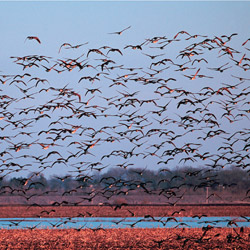 Restoring Floodplains and Wildlife
Restoring Floodplains and WildlifeOne of the largest floodplain restoration projects in the country is taking place just an hour south of Peoria. Emiquon National Wildlife Refuge is the main demonstration site for the Nature Conservancy’s preservation work on the Illinois River and could help guide similar projects all over the world.
The Conservancy is working to restore Emiquon’s 7,100 acres to its earlier ecological state, and today, water has returned to formerly drained floodplain lake basins, and the area is again home to hundreds of native plant and animal species. Prairie grasses and hardwood forest area are returning to the site, as are grassland birds and other animals, such as the river otter, muskrat, beaver and mink.
Over the past two years, this extremely fertile ground was stocked with more than 30 species of fish, including game and non-game species. On April 20, 2009, the Emiquon Preserve opened for angler fishing and is open seven days a week. In addition to fishing, the Preserve is a fantastic site for duck hunting.
Not only does the restoration project offer many wonderful benefits for wildlife and the environment, it also benefits the economies of local communities through tourism dollars.
Our National Bird
There are plenty of sites along the Illinois River Road Scenic Byway ideal for birding, many of which are also home to bald eagles. Wightman Lake, the Emiquon and Chautauqua wildlife refuges, and Starved Rock are great places to watch for these magnificent birds.
Dennis Endicott, president of the Peoria Audubon Society, explained that there are numerous places along the river where bald eagles can be seen every winter. “This past January, I participated in the annual Eagle Count, where volunteers conduct a census of bald eagles along the river from Henry to Havana,” said Endicott. “On this cold, crisp January morning, we stopped at Riverfront Park in Pekin and counted 29 bald eagles through our spotting scopes at this one location. Note that we were counting perhaps a mile up and down the river, but the eagles were there, perching in the trees along the bank.”
Pete Fenner, past president of the Peoria Audubon Society, added that bald eagles are plentiful along the Illinois River from roughly December 1st to March 1st each year. “Nearly anywhere along the river with a vantage point is a good potential viewing spot. Eagles are often seen feeding or resting on the ice, or roosting in the trees along the river. Any large black bird soaring within a mile or two of the river has a good chance of being a bald eagle during that time. They are much less plentiful, but can still be found during other months of the year.”
Fenner explained that eagles can often be seen in surprising places. “One of my favorite spots this year was from the parking lot of the Par-A-Dice Casino. The river was frozen, but there was a spot of open water near the parking lot, between the casino and the Hampton Inn. This provided very close views of eagles, which would catch fish from this spot, or wait until a ring-billed gull had caught a fish. Then the eagle would attack the gull and steal its catch.”
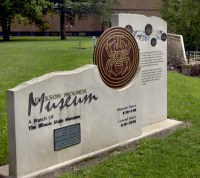 A Dozen Millennia at Dickson Mounds
A Dozen Millennia at Dickson Mounds“Explore 12,000 years of Native American history in the Illinois River Valley at Dickson Mounds Museum,” suggested Museum Director Michael Wiant. A national historic site and branch of the Illinois State Museum, Dickson Mounds is one of the foremost on-site archaeological museums in the country. It currently features several exhibits:
- The River Valley Gallery traces the interaction between the Illinois River and the people who have lived along it from the end of the Ice Age to today.
- The People of the Valley shows different cultures, from Ice Age hunters to the tribal groups that left Illinois in the ninth century, and includes artifacts, murals, hands-on exhibits and more.
- The Reflections on Three Worlds shows the life, culture and archaeology of the Mississippian people whose sites surround the museum.
“The story is told by hundreds of artifacts, exhibits and dioramas; a film which considers the relationship between people and river valley resources; and a multimedia presentation about the lives of native people 1,000 years ago,” added Wiant. “A rooftop observation deck provides an extraordinary view of the river valley, the wetland restoration at Emiquon and some of the ancient sites in the area.”
The museum also encompasses 230 acres that include picnic areas, a playground and Eveland Village, with its excavated remains of early Indian buildings. An exhibit entitled “The American Bald Eagle” will be on display through August, featuring the work of wildlife photographer Jim Miller, as well as panels describing the life cycle, habits and ecology of our national bird. Also through August, an exhibition called Nature Sketches by Gladys and Ruth Dudley will showcase sketches and watercolors by the two sisters. Learn more at museum.state.il.us/ismsites/dickson.iBi

